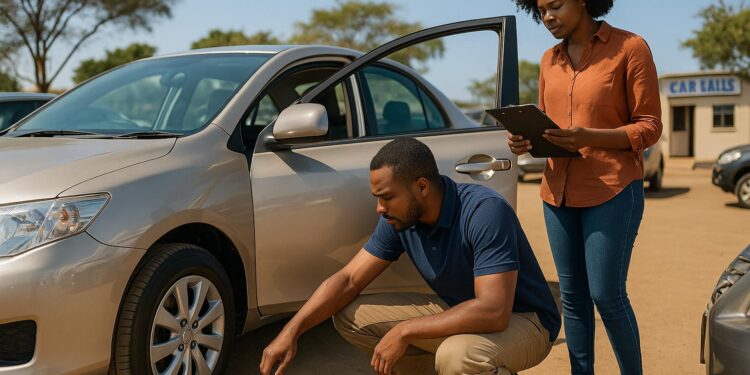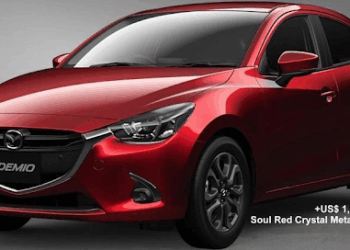Buying a second-hand car in Kenya? Here’s what you need to know upfront:
- Set a Budget: Factor in not just the car’s price (typically KSh 350,000–KSh 500,000 or $2,500–$3,600) but also insurance, maintenance, and fuel costs.
- Inspect Thoroughly: Check the car’s body for rust, dents, and paint issues. Inspect the interior, engine, and key components like the transmission and battery.
- Test Drive: Spend at least 45 minutes driving to assess handling, brakes, and engine performance.
- Verify Documents: Ensure the logbook, NTSA inspection certificate, and ownership details match the car. Use NTSA systems for verification.
- Stick to Reliable Brands: Toyota and Isuzu dominate Kenya’s market for good reason – easy access to spare parts and reliable service.
Pro Tip: Always involve a trusted mechanic for a professional assessment before committing to a purchase.
Top 5 Car Buying Mistakes / Tips in Kenya Dealers Don’t Want …
Current State of Kenya’s Used Car Market
Kenya’s used car market continues to change, shaped by consumer preferences and economic factors. Here’s a closer look at key statistics and popular models that can help inform your buying decision.
Market Trends and Insights
In 2021, Toyota dominated the market with a 47% share, while Isuzu followed at 26.6%. These numbers highlight strong brand loyalty, which significantly influences the used car segment.
By 2024, 5,518 new vehicles were sold. This growing interest in new cars often leads to a steady supply of high-quality used vehicles. The popularity of brands like Toyota and Isuzu in the new car market also means better access to spare parts and reliable service for pre-owned models.
Top Cars for Kenya’s Roads
Some models stand out for their reliability on Kenya’s diverse road conditions. For instance, the Isuzu D-Max captured 21.4% of the market in 2024, showing strong demand for tough pickup trucks that handle both city streets and rural terrain.
Here’s a breakdown of popular vehicle types in the used car market:
| Vehicle Category | Key Features | Best Suited For |
|---|---|---|
| Pickup Trucks | Durable, high ground clearance | Business needs, rural areas |
| SUVs | Versatile, family-friendly | Urban families, rough terrain |
| Compact Cars | Fuel-efficient, easy to park | City driving, small households |
Toyota and Isuzu’s strong presence ensures easy access to spare parts, expert maintenance, and good resale value. If you’re considering a used car, go for models that perform well on Kenya’s varied roads – they tend to hold their value and keep ownership costs manageable over time.
Key Factors Before Purchase
Before checking out a used car, take a moment to define your needs, set a realistic budget, and consider maintenance options.
Matching the Car to Your Needs
Pick a car that fits your lifestyle and driving habits. If you’re often on long road trips, focus on fuel efficiency and comfort.
Here are a few things to think about:
- How many passengers will you typically have?
- How much cargo space do you need?
- What kind of roads will you be driving on?
- Is parking space an issue where you live or work?
- How much fuel will your driving habits require?
Once you’ve figured out your needs, it’s time to get serious about your budget.
Setting a Realistic Budget
Don’t just focus on the sticker price. Factor in insurance, fuel, servicing, road licensing fees, and set aside some money for unexpected repairs. This will give you a clearer picture of the true cost of owning the car.
Access to Parts and Service
Stick to brands that have a strong local presence, making it easier to find parts and service. For example, Toyota is a popular choice in Kenya because of its wide network of service centers and access to genuine parts for many models.
Here’s what to keep in mind:
- Dealer network: Are there reliable service centers nearby?
- Parts availability: Can you easily find genuine replacement parts?
- Service costs: How much will regular maintenance set you back?
- Mechanic expertise: Are local mechanics familiar with the model you’re considering?
Choosing a car that meets your needs and is easy to maintain will save you headaches down the road.
Pre-Purchase Car Checklist
Once you’ve set your budget, the next step is to inspect the car thoroughly. A careful inspection can help you avoid unexpected repair costs later.
Body and Paint Inspection
Start by examining the car’s exterior in natural daylight. Here’s what to focus on:
Paint Consistency
- Look for any color differences that might indicate repainting.
- Check for overspray on the trim, which could suggest recent bodywork.
- Run your hand over the panels to feel for rough or uneven spots.
Structural Concerns
- Inspect door gaps and panel alignment for irregularities.
- Check wheel wells and the bottoms of doors for signs of rust.
- Look for welding marks or repairs that might hint at past accidents.
If you spot minor issues like rust or dents, use them as leverage to negotiate a better price. After the exterior, move on to the interior for further evaluation.
Interior Inspection
The condition of the interior can provide valuable clues about the car’s maintenance and care.
What to Check Inside:
- Seats and Upholstery: Look for tears, stains, or wet spots, and test seat adjustment mechanisms.
- Electronics: Test power windows, locks, and air conditioning to ensure they work.
- Dashboard: Confirm that all warning lights come on briefly during startup.
- Odometer: Compare the mileage with the wear on pedals and other controls.
Red Flags to Watch For:
- Strange odors, which might indicate hidden mold.
- Wet spots under the floor mats, a sign of leaks.
- Excessive wear on driver controls, which might not match the mileage.
- Non-functional power features or accessories.
Don’t forget to lift the floor mats to check for rust or water damage underneath.
Engine and Components Inspection
A proper check under the hood is essential to assess the car’s mechanical health.
Key Visual Checks:
- Look for oil leaks around the engine.
- Inspect hoses and belts for cracks or wear.
- Check the battery terminals for corrosion.
- Examine the transmission fluid for proper color and consistency.
Get a Professional Opinion: Have a mechanic inspect the engine, test the battery, and evaluate the condition of all fluids.
sbb-itb-e5ed0ed
Steps to Buy a Used Car
Here’s a step-by-step guide to help you finalize the process of purchasing a used car, ensuring everything is in order.
Finding Reliable Sellers
When buying a used car in Kenya, it’s important to work with dependable sellers. The safest options include established online car marketplaces and verified dealerships.
Focus on these:
- Reputable Dealerships: Look for sellers with physical locations and verifiable credentials.
- Online Verification: Check the seller’s history and verification status on trusted platforms.
Test Drive Tips
After identifying a trustworthy seller, the next step is a thorough test drive. Aim for at least 45 minutes to assess the car’s condition properly.
Before You Start:
- Take photos of any existing damage for reference.
- Adjust the seat, mirrors, and steering to your comfort.
What to Check During the Drive:
- Engine: Ensure smooth acceleration, monitor the temperature, and listen for unusual noises or vibrations.
- Handling: Test the steering and brakes. Make sure the car tracks straight when braking.
- Transmission:
- For automatics, check for smooth gear changes.
- For manuals, test the clutch and shifting.
A careful test drive will help confirm the car’s condition before moving forward.
Documents and Checks
Key Documents You’ll Need:
- Vehicle logbook
- Current road license
- NTSA inspection certificate
- Sale agreement
- Valid identification for both buyer and seller
Ownership Transfer Process:
- Use the NTSA E-Citizen portal or visit a local office to complete the transfer.
- Pay the necessary transfer fees.
- Update the car’s insurance details.
- Keep copies of all documents for your records.
Verification Steps:
- Confirm that all documents are authentic and match the car’s details.
- Ensure the title is free of any disputes or liens.
- Schedule an NTSA appointment to save time during the process.
Once everything is verified and documented, you’ll be ready to finalize your purchase securely.
How to Spot and Avoid Scams
Warning Signs
Stay cautious when reviewing paperwork and inspecting the vehicle in person.
Document Issues
Be on the lookout for inconsistencies in the vehicle’s records:
- Details in the logbook that don’t match the Copy of Records (CoR)
- Chassis numbers that are missing or appear altered
- Vehicle color records that don’t align with the actual car
Once you’ve reviewed the documents, move on to a physical inspection to uncover any additional issues.
Physical Warning Signs
During your inspection, watch for these red flags:
- Welding marks that could suggest prior accident repairs
- Magnets placed on brake discs, often used to fake mechanical problems
- Oil intentionally splashed on parked cars, a trick to push you toward a specific mechanic
Background Checks
After spotting potential issues, confirm your findings through thorough background checks.
Document Verification
Take these steps to verify the vehicle’s records:
- Use the NTSA Transport Integrated Management System (TIMS) to confirm ownership
- Obtain a Copy of Records (CoR) via mVerified Kenya for KES 940
- Cross-check these key details between the vehicle and its documents:
- Chassis/Frame Number
- Customs Entry Number
- Logbook Number
- Logbook Serial Number
Legal Status Check
Ensure the vehicle is free of legal complications:
- Verify there’s no caveat preventing the transfer of ownership
- Confirm there are no outstanding loans tied to the vehicle
- Check that the car hasn’t been reported stolen
"It is important to remain vigilant of your surroundings as a motorist." – Police
Safety Precautions
Follow these tips to stay safe during the buying process:
- Arrange to meet sellers in well-lit, public areas
- Bring along a trusted friend or mechanic for a second opinion
- Consider installing a tracking system after purchasing the car
- Keep your doors locked and windows up
- Never leave your car running unattended
Keep in mind that white and silver cars are often targeted by thieves, and most thefts occur in public parking areas. Taking these steps can help protect you from scams in Kenya’s used car market.
Wrapping It Up
After going through the key checks and precautions outlined earlier, you’re ready to make a well-informed decision. Buying a second-hand car in Kenya requires careful attention to detail and a methodical approach to steer clear of potential issues.
Be sure to inspect the car thoroughly – inside, outside, and under the hood. Verify all documents through official channels, and don’t skip the test drive. For extra peace of mind, have a professional mechanic evaluate the vehicle’s condition.
Taking these steps ensures you’re making a smart investment. Stick to the checklist provided and work with reputable sellers to find a dependable car that meets your needs.
FAQs
What scams should I be aware of when buying a used car in Kenya?
When purchasing a used car in Kenya, it’s important to stay vigilant against common scams. Be cautious of fake listings with prices that seem too good to be true, as they often involve nonexistent vehicles or fraudulent sellers. Odometer tampering is another frequent issue, where sellers alter mileage readings to make a car appear less used than it actually is. Additionally, watch out for counterfeit documents or stolen vehicles being sold under false ownership.
Other red flags include unlicensed dealers, misleading inspection reports, and bait-and-switch tactics where the car shown is different from the one being sold. To avoid falling victim, always verify the vehicle’s history, request genuine documentation, and, if possible, work with trusted dealerships or professionals. Taking these precautions can help ensure a safe and legitimate purchase.
How can I confirm a car’s documents are legitimate and ensure it hasn’t been stolen?
To confirm a car’s documents are legitimate and verify it hasn’t been stolen, start by checking its Vehicle Identification Number (VIN). The VIN provides details about the car’s history, including previous ownership, accident records, and whether it’s been reported stolen.
You should also cross-check the vehicle’s registration and chassis numbers with the official records at the relevant authorities. This ensures the ownership details match the seller’s claims. Always request to see the original logbook and confirm the seller’s identification matches the registered owner. Taking these steps will help you avoid potential scams and ensure a smooth purchase process.
Why should you involve a trusted mechanic when buying a second-hand car, and what key areas should they inspect?
Involving a trusted mechanic when buying a second-hand car is essential to avoid costly surprises and ensure the vehicle is in good condition. A mechanic can spot hidden issues that may not be obvious during a casual inspection.
They should check critical areas such as the engine, transmission, brakes, steering, suspension, and electrical system. Additionally, they can inspect the tires, battery, fluid levels, and overall structural integrity to confirm the car is safe and roadworthy. This step can give you peace of mind and help you make an informed purchase decision.
Related posts
- Best used cars to buy in Kenya
- Car prices in Nairobi 2025
- Where to buy certified used cars in Kenya
- Most sold cars in Kenya this year




